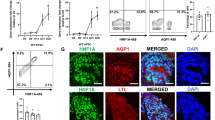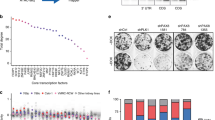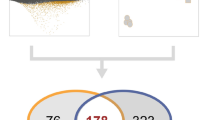Abstract
Hepatocyte nuclear factor 4α (HNF4α) is a tissue-specific transcription factor known to regulate a large number of genes in hepatocytes and pancreatic β cells. Although HNF4α is highly expressed in some sections of the kidney, little is known about its role in this organ and about HNF4α-regulated genes in the kidney cells. The abundance and activity of HNF4α are frequently reduced in renal cell carcinoma (RCC) indicating some tumor suppressing function of HNF4α in renal cells. To determine the potential role of HNF4α in RCC, we used Flp recombinase-mediated gene integration to generate human embryonic kidney cells (HEK293) that conditionally express wild-type or mutated HNF4α. Expression of wild-type HNF4α but not of the mutants led to reduction of proliferation and alterations of cell morphology. These effects were reversible and induced at physiological concentrations of HNF4α. Using gene expression profiling by microarrays, we determined genes regulated by HNF4α. Interestingly, many of the genes regulated by HNF4α have been shown to be deregulated in RCC microarray studies. These genes (ACY1, WT1, SELENBP1, COBL, EFHD1, AGXT2L1, ALDH5A1, THEM2, ABCB1, FLJ14146, CSPG2, TRIM9 and HEY1) are good candidates for genes whose activity is changed upon the decrease of HNF4α in RCC.
This is a preview of subscription content, access via your institution
Access options
Subscribe to this journal
Receive 50 print issues and online access
$259.00 per year
only $5.18 per issue
Buy this article
- Purchase on Springer Link
- Instant access to full article PDF
Prices may be subject to local taxes which are calculated during checkout







Similar content being viewed by others
Accession codes
References
Berasain C, Herrero JI, Garcia-Trevijano ER, Avila MA, Esteban JI, Mato JM and Prieto J . (2003). Hepatology, 38, 148–157.
Blondeau F, Laporte J, Bodin S, Superti-Furga G, Payrastre B and Mandel JL . (2000). Hum. Mol. Genet., 9, 2223–2229.
Boer JM, Huber WK, Sultmann H, Wilmer F, von Heydebreck A, Haas S, Korn B, Gunawan B, Vente A, Fuzesi L, Vingron M and Poustka A . (2001). Genome Res., 11, 1861–1870.
Chabardes-Garonne D, Mejean A, Aude JC, Cheval L, Di Stefano A, Gaillard MC, Imbert-Teboul M, Wittner M, Balian C, Anthouard V, Robert C, Segurens B, Wincker P, Weissenbach J, Doucet A and Elalouf JM . (2003). Proc. Natl. Acad. Sci. USA, 100, 13710–13715.
Chen WS, Manova K, Weinstein DC, Duncan SA, Plump AS, Prezioso VR, Bachvarova RF and Darnell Jr JE . (1994). Genes Dev., 8, 2466–2477.
Chiba H, Itoh T, Satohisa S, Sakai N, Noguchi H, Osanai M, Kojima T and Sawada N . (2005). Exp. Cell Res., 302, 11–21.
Choi JK, Choi JY, Kim DG, Choi DW, Kim BY, Lee KH, Yeom YI, Yoo HS, Yoo OJ and Kim S . (2004). FEBS Lett., 565, 93–100.
Del Sal G, Collavin L, Ruaro ME, Edomi P, Saccone S, Valle GD and Schneider C . (1994). Proc. Natl. Acad. Sci. USA, 91, 1848–1852.
Drewes T, Senkel S, Holewa B and Ryffel GU . (1996). Mol. Cell. Biol., 16, 925–931.
Gieseg MA, Cody T, Man MZ, Madore SJ, Rubin MA and Kaldjian EP . (2002). BMC Bioinform., 3, 26.
Grewal JS, Tsai JY and Khan SR . (2004). Biochem. J., 387, 609–616.
Gupta RK and Kaestner KH . (2004). Trends Mol. Med., 10, 521–524.
Hattersley AT . (1998). Diabet. Med., 15, 15–24.
Hayhurst GP, Lee YH, Lambert G, Ward JM and Gonzalez FJ . (2001). Mol. Cell. Biol., 21, 1393–1403.
Higgins JP, Shinghal R, Gill H, Reese JH, Terris M, Cohen RJ, Fero M, Pollack JR, Van De RM and Brooks JD . (2003). Am. J. Pathol., 162, 925–932.
Hill KE, Lloyd RS and Burk RF . (1993). Proc. Natl. Acad. Sci. USA, 90, 537–541.
Ishiyama T, Kano J, Minami Y, Iijima T, Morishita Y and Noguchi M . (2003). Cancer Sci., 94, 757–763.
Jiang S, Tanaka T, Iwanari H, Hotta H, Yamashita H, Kumakura J, Watanabe Y, Uchiyama Y, Aburatani H, Hamakubo T, Kodama T and Naito M . (2003). Nucl. Recept., 1, 5.
Kowalczyk AP, Palka HL, Luu HH, Nilles LA, Anderson JE, Wheelock MJ and Green KJ . (1994). J. Biol. Chem., 269, 31214–31223.
Laine B, Eeckhoute J, Suaud L, Briche I, Furuta H, Bell GI and Formstecher P . (2000). FEBS Lett., 479, 41–45.
Lausen J, Thomas H, Lemm I, Bulman M, Borgschulze M, Lingott A, Hattersley AT and Ryffel GU . (2000). Nucleic Acids Res., 28, 430–437.
Lazarevich NL, Cheremnova OA, Varga EV, Ovchinnikov DA, Kudrjavtseva EI, Morozova OV, Fleishman DI, Engelhardt NV and Duncan SA . (2004). Hepatology, 39, 1038–1047.
Lenburg ME, Liou LS, Gerry NP, Frampton GM, Cohen HT and Christman MF . (2003). BMC Cancer, 3, 31.
Li J, Ning G and Duncan SA . (2000). Genes Dev., 14, 464–474.
Lim LP, Lau NC, Garrett-Engele P, Grimson A, Schelter JM, Castle J, Bartel DP, Linsley PS and Johnson JM . (2005). Nature, 433, 769–773.
Linehan WM and Zbar B . (2004). Cancer Cell, 6, 223–228.
Naiki T, Nagaki M, Shidoji Y, Kojima H, Imose M, Kato T, Ohishi N, Yagi K and Moriwaki H . (2002). J. Biol. Chem., 277, 14011–14019.
Odom DT, Zizlsperger N, Gordon DB, Bell GW, Rinaldi NJ, Murray HL, Volkert TL, Schreiber J, Rolfe PA, Gifford DK, Fraenkel E, Bell GI and Young RA . (2004). Science, 303, 1378–1381.
Parviz F, Matullo C, Garrison WD, Savatski L, Adamson JW, Ning G, Kaestner KH, Rossi JM, Zaret KS and Duncan SA . (2003). Nat. Genet., 34, 292–296.
Ryffel GU . (2001). J. Mol. Endocrinol., 27, 11–29.
Ryffel GU and Lingott A . (2000). Mech. Dev., 90, 65–75.
Sel S, Ebert T, Ryffel GU and Drewes T . (1996). Cancer Lett., 101, 205–210.
Silacci P, Mazzolai L, Gauci C, Stergiopulos N, Yin HL and Hayoz D . (2004). Cell Mol. Life Sci., 61, 2614–2623.
Sladek FM and Seidel SD . (2001). Nuclear Receptors and Genetic Disease. Burris TB, McCabe ERB (eds). Academic Press: San Diego, pp. 309–361.
Stumpf H, Senkel S, Rabes HM and Ryffel GU . (1995). Carcinogenesis, 16, 143–145.
Takahashi M, Yang XJ, Sugimura J, Backdahl J, Tretiakova M, Qian CN, Gray SG, Knapp R, Anema J, Kahnoski R, Nicol D, Vogelzang NJ, Furge KA, Kanayama H, Kagawa S and Teh BT . (2003). Oncogene, 22, 6810–6818.
Taylor DG, Haubenwallner S and Leff T . (1996). Nucleic Acids Res., 24, 2930–2935.
Thomas H, Senkel S, Erdmann S, Arndt T, Turan G, Klein-Hitpass L and Ryffel GU . (2004). Nucleic Acids Res., 32, e150.
Torban E and Goodyer PR . (1998). Biochim. Biophys. Acta, 1401, 53–62.
Wagner KD, Wagner N and Schedl A . (2003). J. Cell Sci., 116, 1653–1658.
Wang H, Iakova P, Wilde M, Welm A, Goode T, Roesler WJ and Timchenko NA . (2001). Mol. Cell, 8, 817–828.
Wang H, Maechler P, Antinozzi PA, Hagenfeldt KA and Wollheim CB . (2000). J. Biol. Chem., 275, 35953–35959.
Werdien D, Peiler G and Ryffel GU . (2001). Nucleic Acids Res., 29, E53.
Xu L, Hui L, Wang S, Gong J, Jin Y, Wang Y, Ji Y, Wu X, Han Z and Hu G . (2001). Cancer Res., 61, 3176–3181.
Young AN, Amin MB, Moreno CS, Lim SD, Cohen C, Petros JA, Marshall FF and Neish AS . (2001). Am. J. Pathol., 158, 1639–1651.
Acknowledgements
We thank Gülüzar Turan and Sabine Senkel for their skillful technical assistance. We are also grateful to Nadine Esser and Adriane Parchatka for the assistance in microarray analysis. We also thank V Schumacher, KJ Green, J Laporte and KE Hill for kindly providing plasmids used in this work. This work was supported by the Deutsche Forschungsgemeinschaft (Ry 5/4-5).
Author information
Authors and Affiliations
Corresponding author
Additional information
Supplementary information accompanies the paper on Oncogene website (http://www.nature.com/onc)
Supplementary information
Rights and permissions
About this article
Cite this article
Lucas, B., Grigo, K., Erdmann, S. et al. HNF4α reduces proliferation of kidney cells and affects genes deregulated in renal cell carcinoma. Oncogene 24, 6418–6431 (2005). https://doi.org/10.1038/sj.onc.1208794
Received:
Revised:
Accepted:
Published:
Issue Date:
DOI: https://doi.org/10.1038/sj.onc.1208794
Keywords
This article is cited by
-
Nuclear receptor HNF4α performs a tumor suppressor function in prostate cancer via its induction of p21-driven cellular senescence
Oncogene (2020)
-
Differentiation therapy and the mechanisms that terminate cancer cell proliferation without harming normal cells
Cell Death & Disease (2018)
-
A cross-species approach to identify transcriptional regulators exemplified for Dnajc22 and Hnf4a
Scientific Reports (2017)
-
Decreased selenium-binding protein 1 mRNA expression is associated with poor prognosis in renal cell carcinoma
World Journal of Surgical Oncology (2014)
-
Fraternal twins: Swiprosin-1/EFhd2 and Swiprosin-2/EFhd1, two homologous EF-hand containing calcium binding adaptor proteins with distinct functions
Cell Communication and Signaling (2011)



